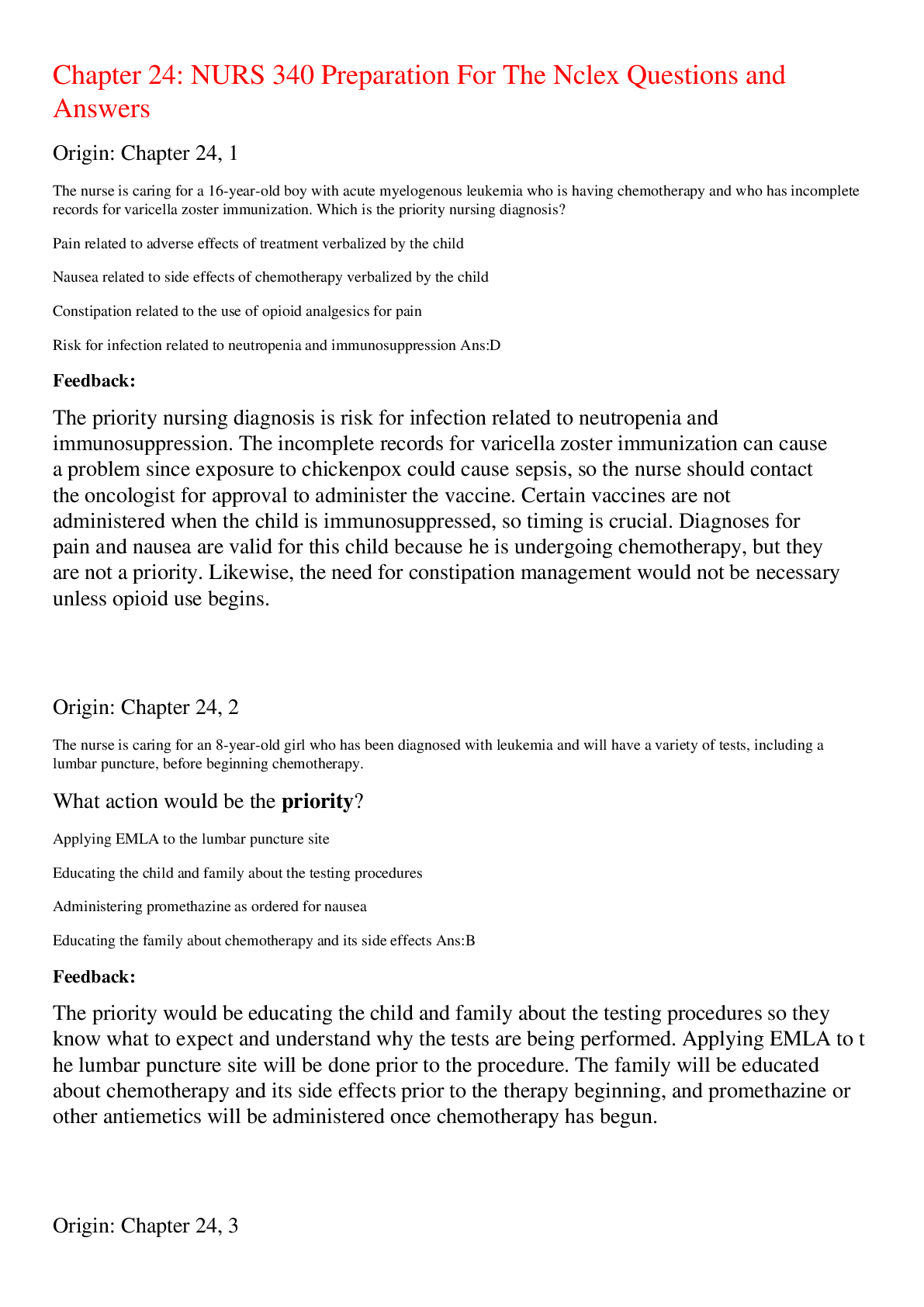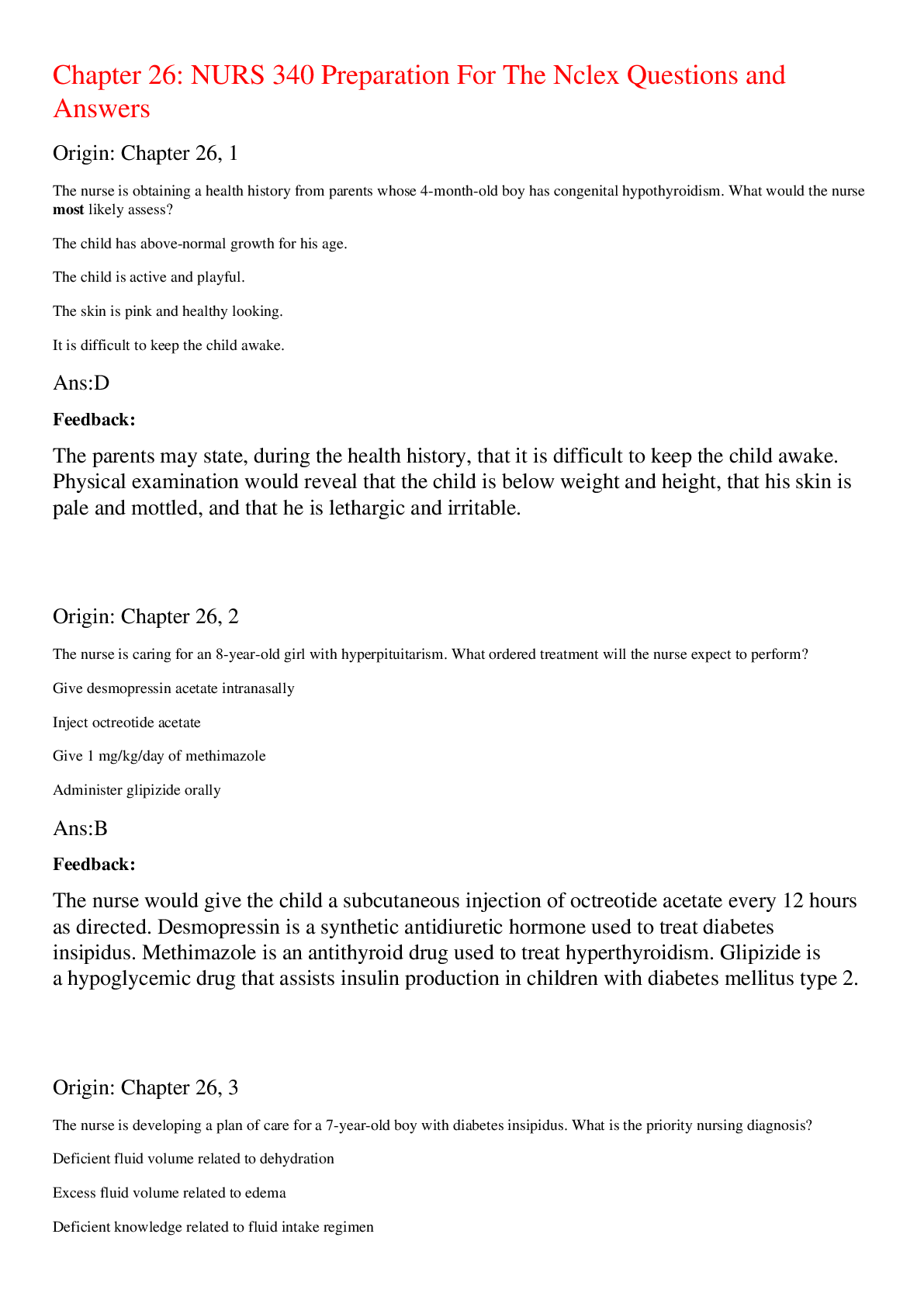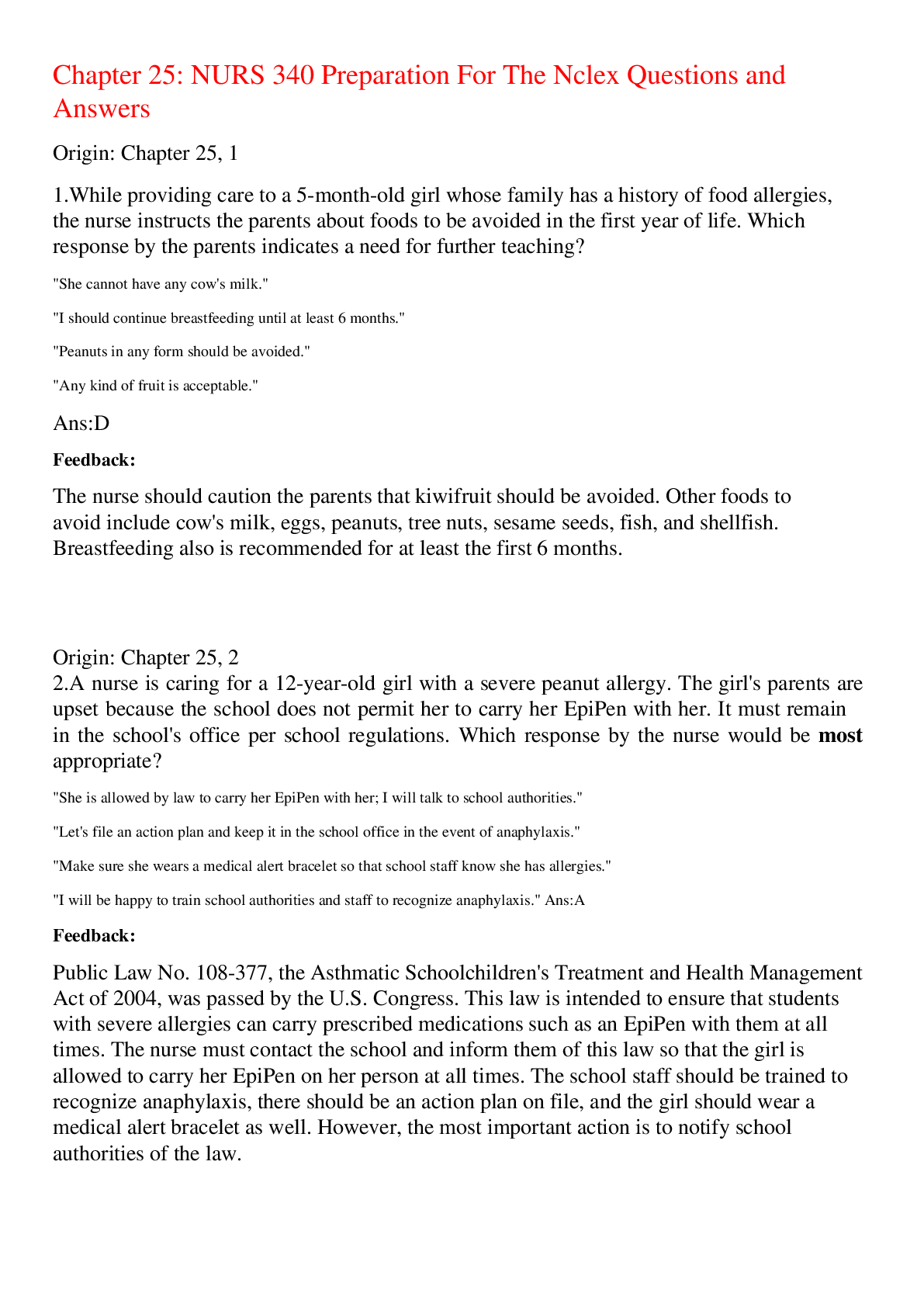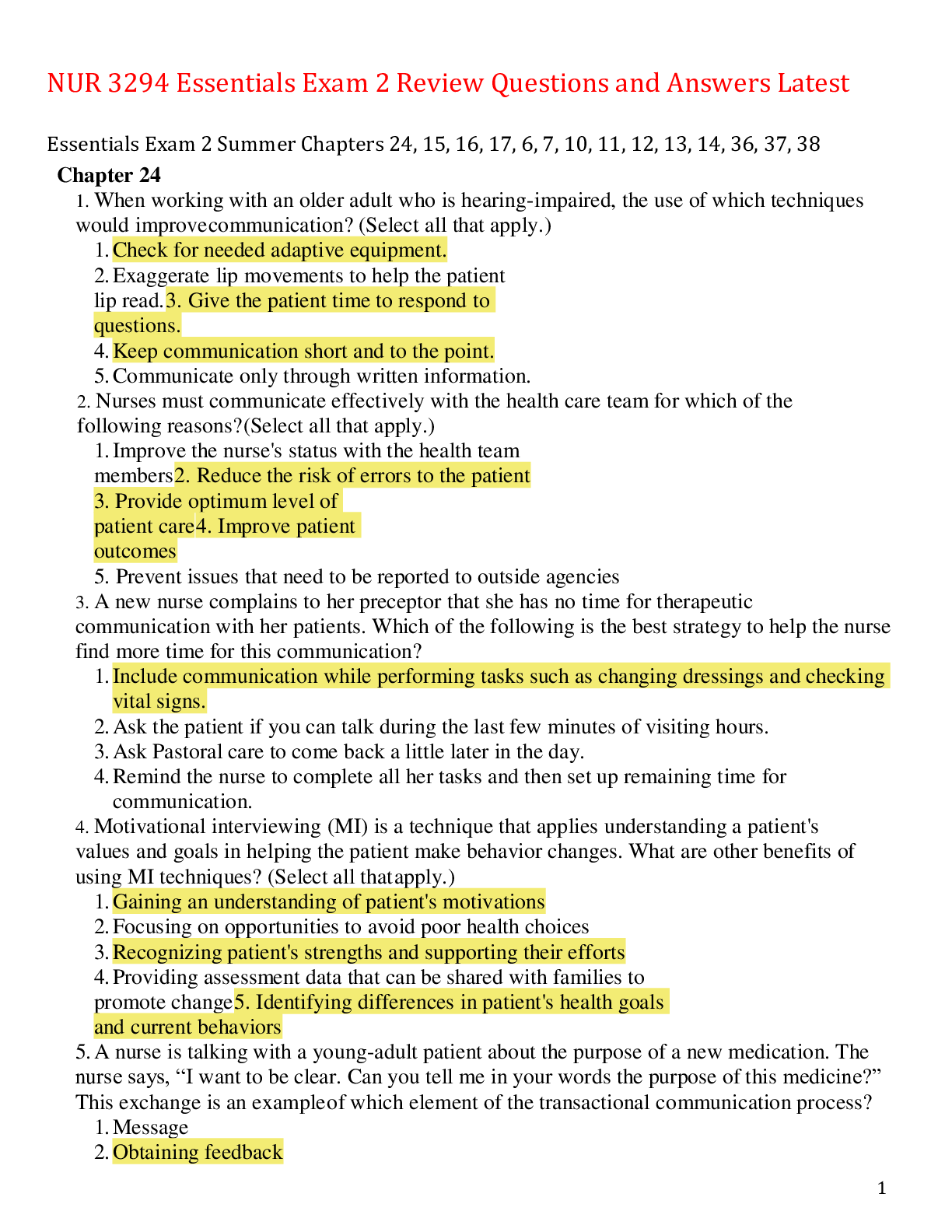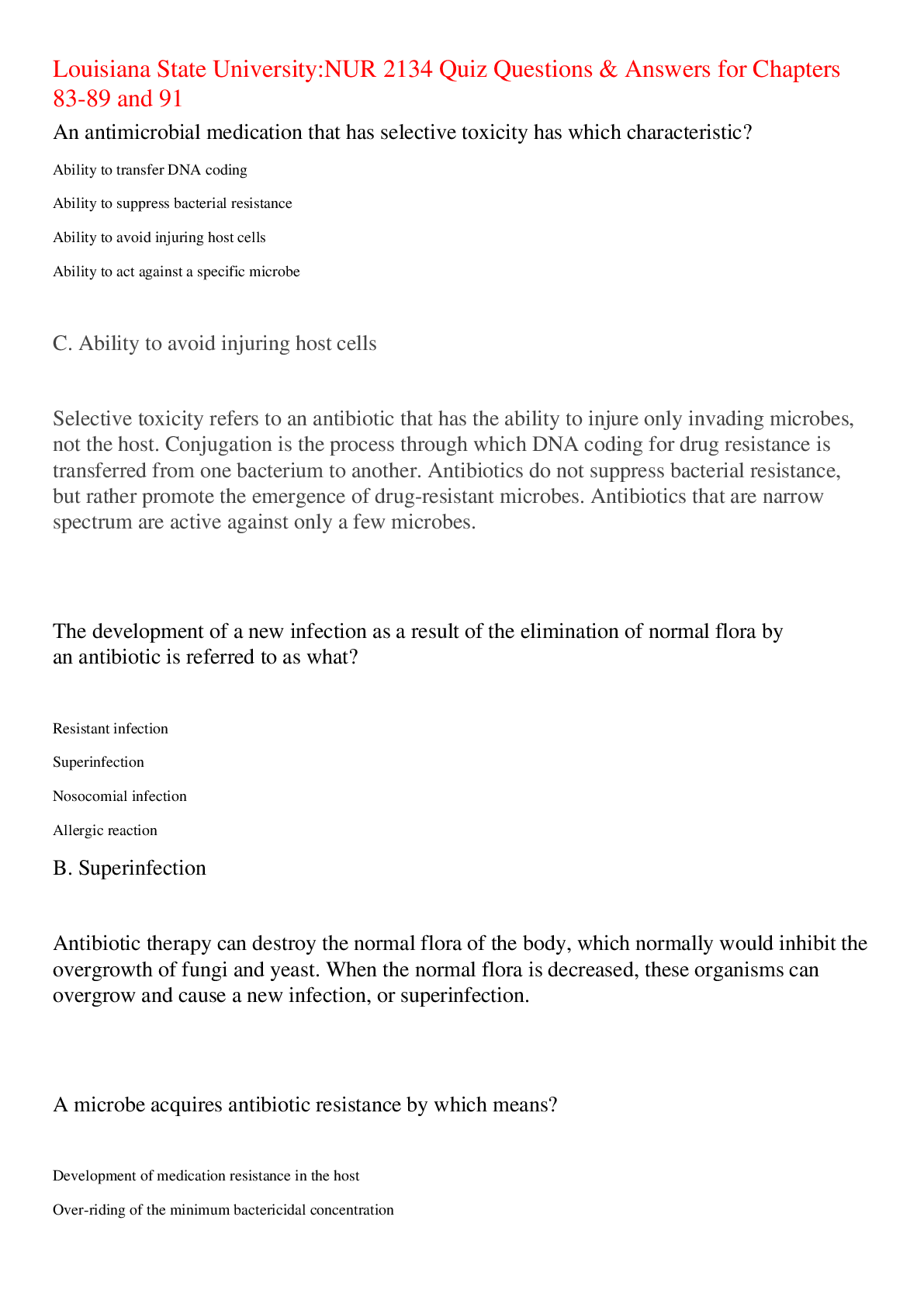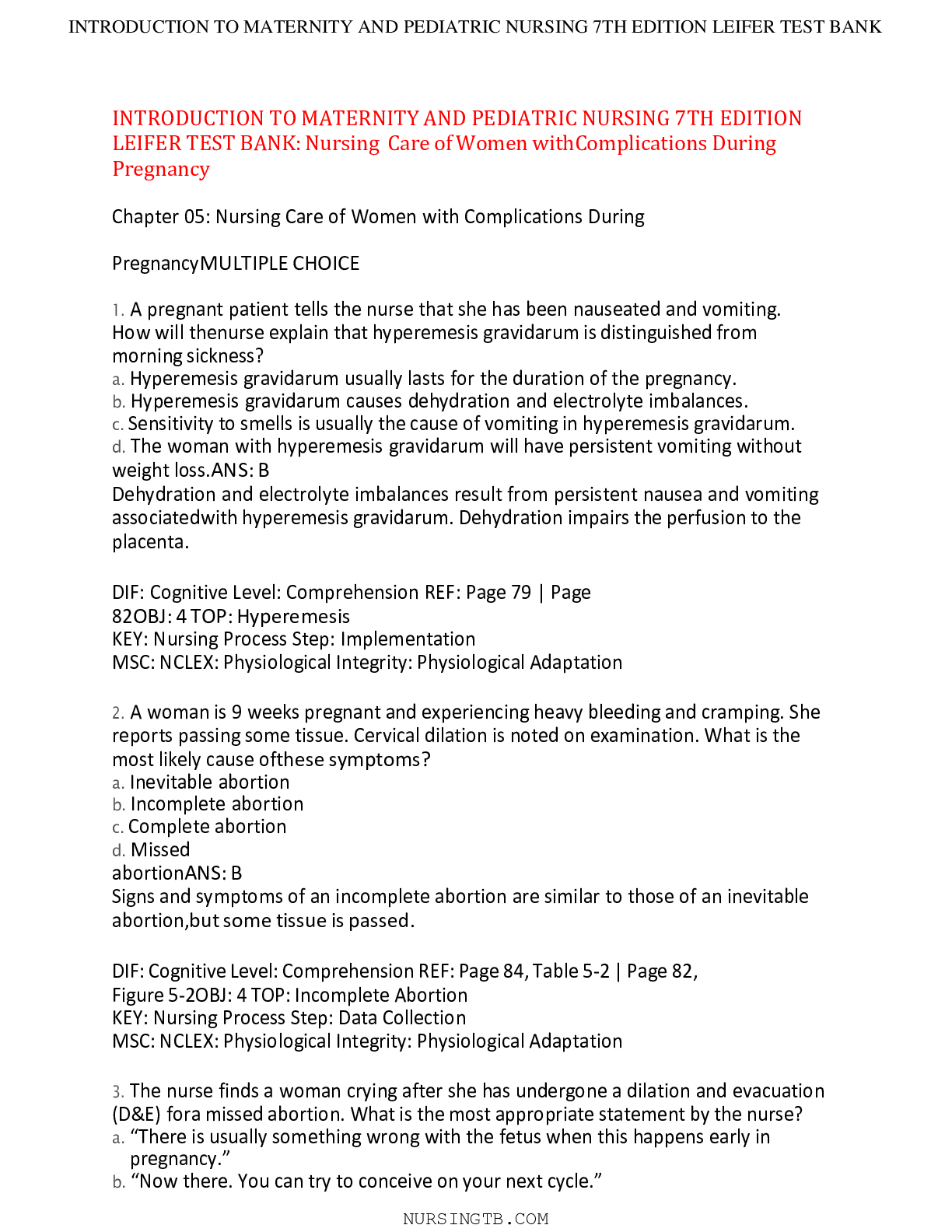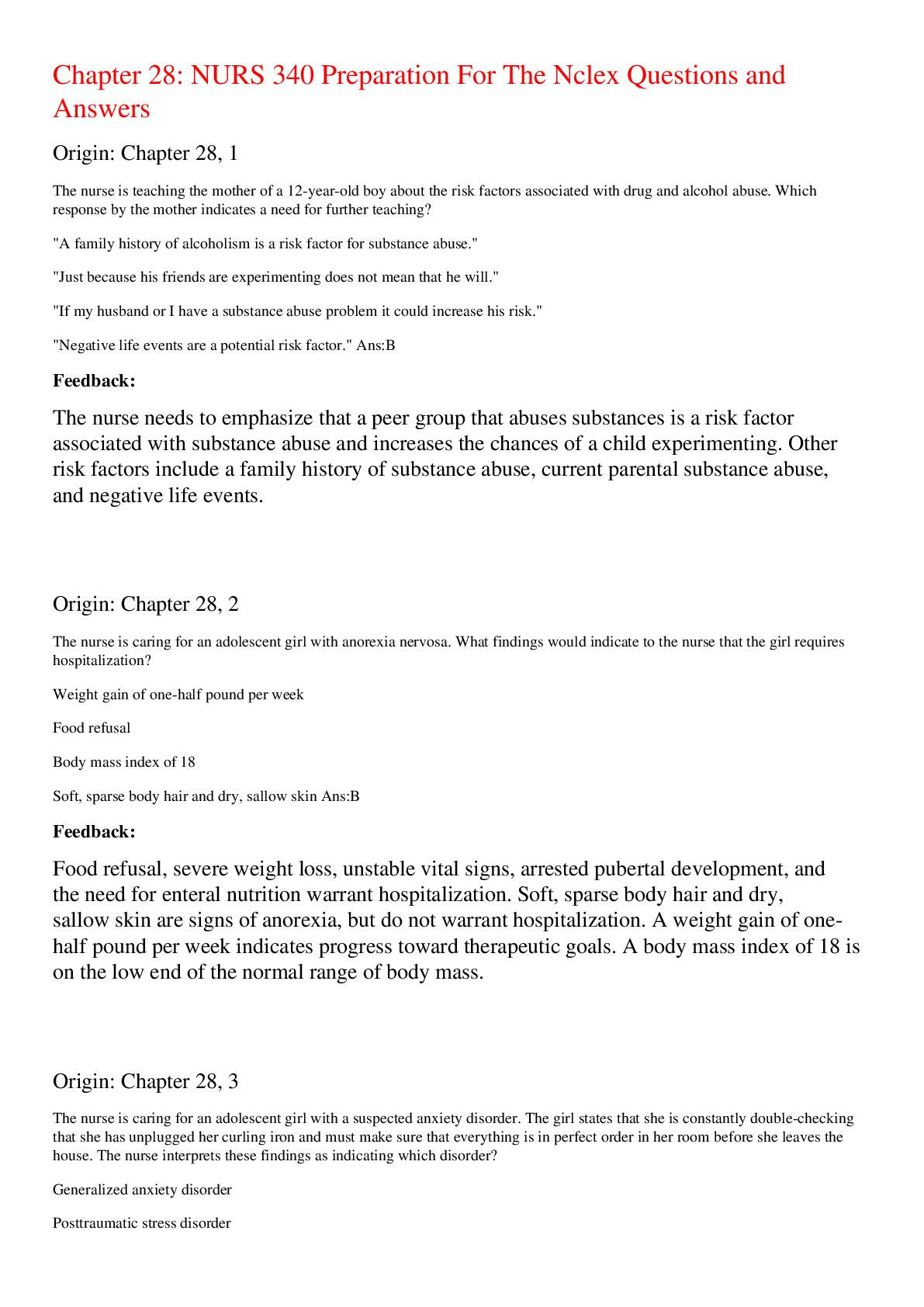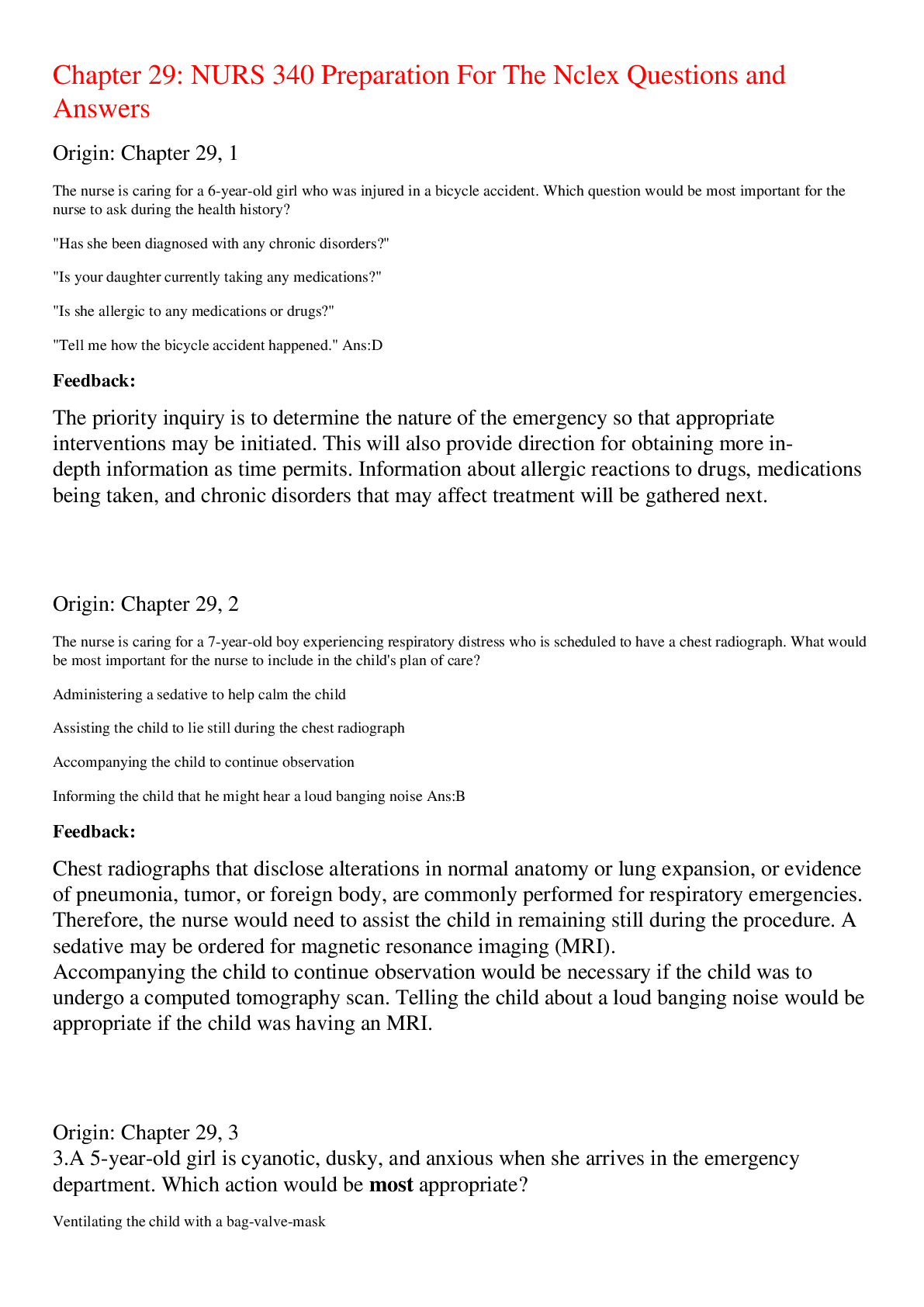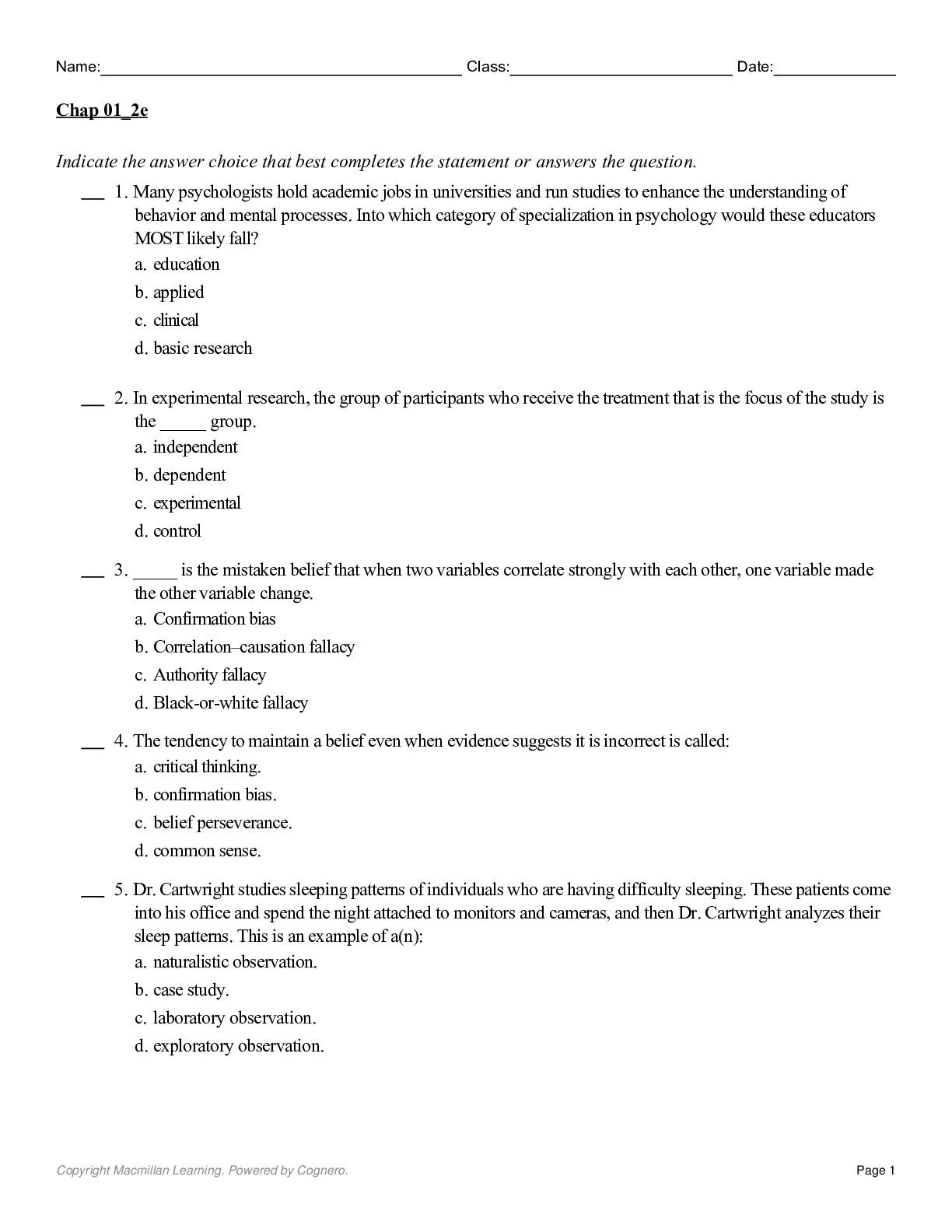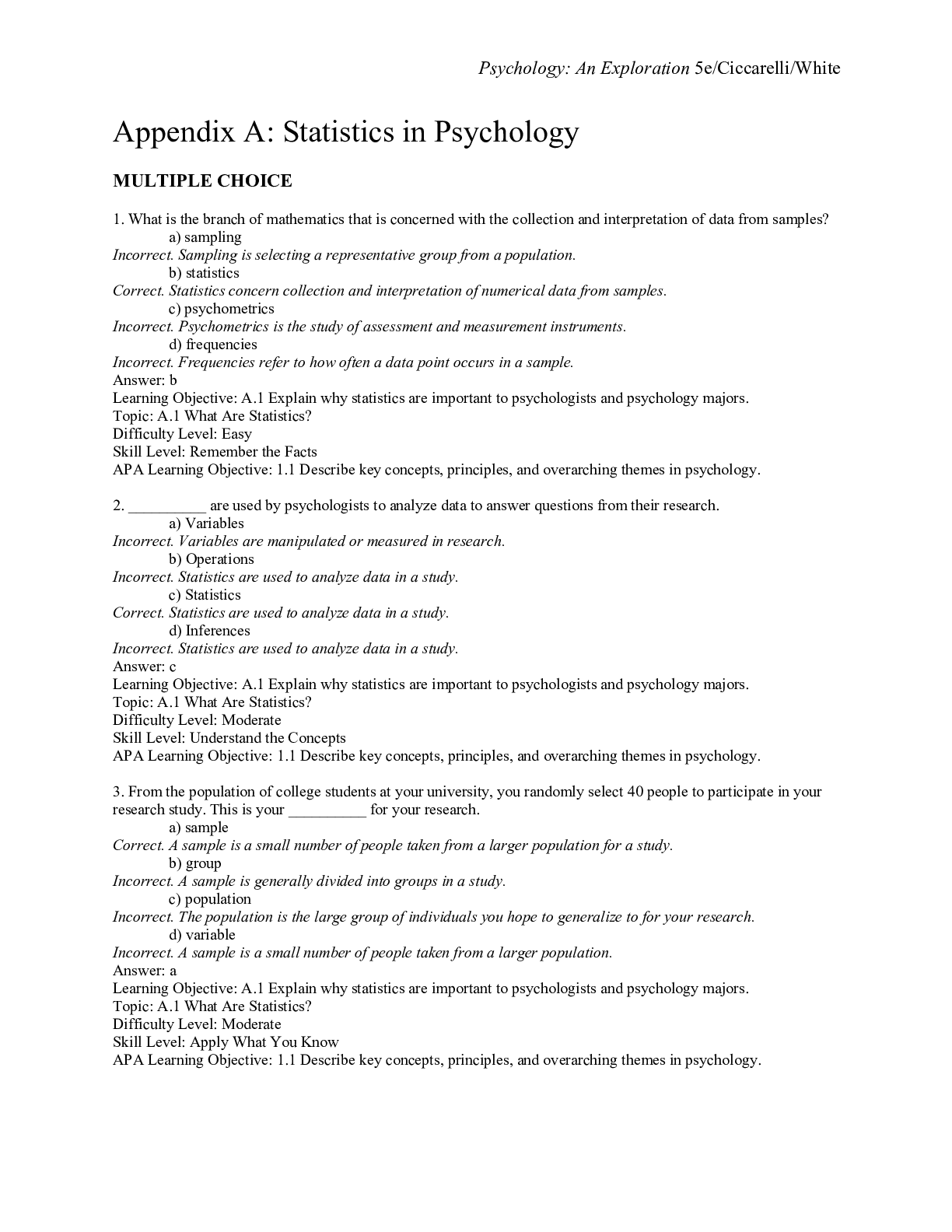*NURSING > TEST BANKS > Chapter 27: NURS 340 Preparation For The Nclex Questions and Answers,100% CORRECT (All)
Chapter 27: NURS 340 Preparation For The Nclex Questions and Answers,100% CORRECT
Document Content and Description Below
Chapter 27: NURS 340 Preparation For The Nclex Questions and Answers Origin: Chapter 27, 1 1. The nurse is teaching a couple about the pros and cons of genetic testing. Which statement best describ ... es the capabilities of genetic testing? A) "Various genetic tests help the physician choose appropriate treatments." B) "Genetic testing helps couples avoid having children with fatal diseases." C) "Genetic tests identify people at high risk for preventable conditions." D) "Some genetic tests can give a probability for developing a disorder." Ans: D Feedback: The fact that some tests only provide a probability for developing a disorder raises a problem. A serious limitation of these susceptibility tests is that some people who carry a disease-associated mutation never develop the disease. The other statements affirm the value of genetic tests. Origin: Chapter 27, 2 2. The nurse is caring for a couple who is having a triple screen done. The nurse would least likely expect what level to be tested? A) a-Fetoprotein B) Human chorionic gonadotropin C) Unconjugated estriol D) Testosterone Ans: D Feedback: A triple screen tests a-fetoprotein (AFP), human chorionic gonadotropin (hCG), and unconjugated estriol (uE3). Testosterone is not included. Origin: Chapter 27, 3 3. The nurse is caring for 3-day-old girl with Down syndrome whose mother had no prenatal care. What is the priority nursing diagnosis? A) Imbalanced nutrition, less than body requirements related to the effects of hypotonia B) Deficient knowledge related to the presence of a genetic disorder C) Delayed growth and development related to a cognitive impairment D) Impaired physical mobility related to poor muscle tone Ans: A Feedback: Children with Down syndrome may have difficulty sucking and feeding due to lack of muscle tone and the structure of their mouths and tongues. This can lead to poor nutritional intake and makes this the priority diagnosis. This also uses the strategy that physiologic needs have priority using Maslow's hierarchy of needs. Deficient knowledge due to lack of information about the disorder is a close second in priority, as the mother did not know of her daughter's condition before birth and has much to learn now. This child is at risk for a number of complications such as infection, heart disease, and leukemia and will require frequent assessment. Most children with Down syndrome experience some degree of intellectual disability, but early intervention will allow the child maximum development within the limits of the disease. Mobility is delayed but should not be a problem at this time. Origin: Chapter 27, 4 4. The nurse is assessing a 4-year-old boy whose mother was 40 years old when he was born. Which finding suggests this child has a genetic disorder? A) Inquiry determines the child had feeding problems. B) Observation shows nasal congestion and excess mucus. C) Inspection reveals low-set ears with lobe creases. D) Auscultation reveals the presence of wheezing. Ans: C Feedback: Low-set ears are associated with numerous genetic dysmorphisms. Additionally, the mother's age during pregnancy is a risk factor for genetic disorders. Feeding problems could have been due to low birthweight, prematurity, or a variety of other reasons. The nasal congestion may be a cold. The wheezing could be bronchiolitis or asthma. Origin: Chapter 27, 5 5. The nurse is teaching the parents of a 1-month-old girl with Down syndrome how to maintain good health for the child. Which instruction would the nurse be least likely to include? A) Getting cervical radiographs between 3 and 5 years of age B) Adhering to the special dietary needs of the child C) Getting an echocardiogram before 3 months of age D) Monitoring for symptoms of respiratory infection Ans: B Feedback: Children with Down syndrome do not require a special diet unless underlying gastrointestinal disease is present. However, a balanced, high-fiber diet and regular exercise are important. Getting cervical radiographs between 3 and 5 years of age is the screening method for atlantoaxial instability, which is seen in about 14% of children with Down syndrome. Evaluation by a pediatric cardiologist before 3 months of age, including an echocardiogram, is important since children with Down syndrome are at higher risk for heart disease. The child will be more susceptible to infectious diseases. Origin: Chapter 27, 6 6. The nurse is counseling a couple who suspect that they could bear a child with a genetic abnormality. What would be most important for the nurse to incorporate into the plan of care when working with this family? A) Gathering information from at least three generations B) Informing the family of the need for a wide range of information C) Maintaining the confidentiality of the information D) Presenting the information in a nondirective manner Ans: D Feedback: It is essential to respect client autonomy and present information in a factual, nondirective manner. In these situations, the nurse needs to understand that the choice is the couple's to make. Gathering information for three generations obtains a broad overview of what has been seen in both sides of the family. Maintaining confidentiality of the information is as important as with any other client information gathered. Informing family of the need for information is necessary because of its personal nature. Origin: Chapter 27, 7 7. The nurse is obtaining the health history for a 15-month-old boy from the parents. The child is not yet speaking. Which finding would be eliminated as a risk factor for a possible genetic disorder? A) The child is male and Caucasian. B) The grandmother and father have hearing impairments. C) The child was a breech delivery 3 weeks early. D) The mother was 37 when she became pregnant. Ans: A Feedback: Being male and Caucasian are risk factors for acute lymphoblastic leukemia, not genetic disorders. The fact that the child's grandmother and father have hearing impairments suggests a genetic disorder. The facts that the mother was 37 when she became pregnant and had a breech delivery 3 weeks early are also risk factors for genetic disorders. Origin: Chapter 27, 8 8. The nurse is caring for a 1-month-old girl with low-set ears and severe hypotonia who was diagnosed with trisomy 18. Which nursing diagnosis would the nurse identify as most likely? A) Interrupted family process related to the child's diagnosis B) Deficient knowledge deficit related to the genetic disorder C) Grieving related to the child's poor prognosis D) Ineffective coping related to stress of providing care Ans: C Feedback: Grieving related to the child's prognosis is a diagnosis specific to this child's care. The prognosis for trisomy 18 is that the child will not survive beyond the first year of life. Ineffective coping related to the stress of providing care, deficient knowledge related to the genetic disorder, and interrupted family process due to the child's diagnosis could be appropriate for any family of a child with a genetic disorder. Origin: Chapter 27, 9 9. The nurse is caring for a 9-year-old boy with achondroplasia. What will the nurse's assessment reveal? A) Narrow passages from the nose to the throat B) Slim stature, hypotonia, and a narrow face C) Craniosynostosis and a small nasopharynx D) Trident hand and persistent otitis media Ans: D Feedback: Achondroplasia results in disordered growth with an average adult height of 4 feet for males or females. Other distinguishing symptoms are a separation between the middle and ring fingers, called trident hand, and persistent otitis media and middle ear dysfunction. Narrow passages from nose to throat are a symptom of CHARGE syndrome. Slim stature, hypotonia, and a narrow face are symptoms of Marfan syndrome. Craniosynostosis and a small nasopharynx are symptoms of Apert syndrome. Origin: Chapter 27, 10 10. The nurse is teaching a couple about X-linked disorders. They are concerned that they might pass on hemophilia to their children. What response by the couple indicates the need for further teaching? A) "The father can't be a carrier if he doesn't have hemophilia." B) "If the father doesn't have it, then his kids won't either." C) "If the mother is a carrier, her daughter could be one too." D) "If the mother is a carrier, her sons may have hemophilia." Ans: B Feedback: Hemophilia is an X-linked recessive disorder. This means that both the father and the mother must have the gene for hemophilia to pass it on to their children. Also, their male children will have hemophilia, while their female children have only a 50% chance of having the disorder. If the father has hemophilia and the mother has hemophilia, their children will have the disease. If the father has hemophilia and the mother is a carrier, all their children have a 50% chance of getting the disease. Origin: Chapter 27, 11 11. When teaching a class about trisomy 21, the instructor would identify the cause of this disorder as: A) nondisjunction. B) X-linked recessive inheritance. C) genomic imprinting. D) autosomal dominant inheritance. Ans: A Feedback: Trisomy 21 is an example of a genetic disorder involving an abnormality in chromosomal number due to nondisjunction. X-linked recessive inheritance disorders, such as hemophilia and Duchenne muscular dystrophy, involve altered genes on the X chromosome. Genomic imprinting disorders, such as Prader-Willi syndrome, involve expression of only the maternal or paternal allele, with the other being inactive. Autosomal dominant inheritance disorders, such as neurofibromatosis and achondroplasia, involve a single gene in the heterozygous state that is capable of producing the phenotype, thus overshadowing the normal gene. Origin: Chapter 27, 12 12. The nurse is preparing a presentation to a local community group about genetic disorders and the types of congenital anomalies that can occur. What would the nurse include as a major congenital anomaly? A) Overlapping digits B) Polydactyly C) Umbilical hernia D) Cleft palate Ans: D Feedback: Cleft palate is considered a major congenital anomaly, one that creates a significant medical problem or requires surgical or medical management. Overlapping digits, polydactyly, and umbilical hernia are considered minor congenital anomalies because they do not cause an increase in morbidity in and of themselves. Origin: Chapter 27, 13 13. The nurse is caring for a couple who have just learned that their infant has a genetic disorder. What would be least appropriate for the nurse to do at this time? A) Actively listening to the parents' concerns B) Teaching the parents about the child's medical needs C) Providing time for the parents to ask questions D) Offering suggestions for support services Ans: B Feedback: The parents are most likely overwhelmed with learning the diagnosis and are dealing with a wide range of emotions and reactions. Therefore, it would be inappropriate at this time to attempt teaching them. Rather, the nurse would provide emotional support, actively listening to the parents, allowing time for questions, and offering suggestions for support to assist them in dealing with this new challenge. Teaching can be done at a later time. Origin: Chapter 27, 14 14. When providing guidance to the parents of a child with Down syndrome, which interaction would be most appropriate? A) Encourage the parents to home-school the child. B) Advise the parents that the child will need monthly thyroid testing. C) Instruct them on the need for yearly dental visits. D) Teach the parents about the need for a high-fiber diet. Ans: D Feedback: A high-fiber intake is important for children with Down syndrome because their lack of muscle tone may decrease peristalsis, leading to constipation. Early intervention programs with special education are important to promote growth and development. The child should be integrated into mainstream education whenever possible. Children with Down syndrome should undergo thyroid testing yearly and see the dentist every 6 months. Origin: Chapter 27, 15 15. What finding would lead the nurse to suspect that a child has Turner syndrome? A) Webbed neck B) Microcephaly C) Gynecomastia D) Cognitive delay Ans: A Feedback: Manifestations of Turner syndrome include webbed neck, low posterior hairline, wide- spaced nipples, edema of the hands and feet, amenorrhea, and absence of secondary sex characteristics, along with short stature and slow growth. Microcephaly is commonly associated with trisomy 13. Gynecomastia and cognitive delay are associated with Klinefelter syndrome. Origin: Chapter 27, 16 16. When performing a physical examination on a small child, the nurse observes approximately 8 to 10 light-brown spots concentrated primarily on the trunk and extremities, two small lumps on the posterior trunk, and axillary freckling. What condition do these findings suggest? A) Klinefelter syndrome B) Neurofibromatosis C) Fragile X syndrome D) Sturge-Weber syndrome Ans: B Feedback: The hallmark of neurofibromatosis is café-au-lait spots appearing all over the body, particularly the trunk and extremities. Additional findings include benign tumors, axillary freckling, and pigmented nevi. Klinefelter syndrome is associated with a lack of secondary sex characteristics, decreased facial hair, gynecomastia, decreased pubic hair, and hypogonadism. Fragile X syndrome is manifested by minor dysmorphic features and developmental delay. Sturge-Weber syndrome is associated with facial nevus, seizures, hemiparesis, and intracranial calcifications. Origin: Chapter 27, 17 17. After teaching a class about inborn errors of metabolism, the instructor determines that additional teaching is needed when the class identifies what as an example of an inborn error of metabolism? A) Galactosemia B) Maple syrup urine disease C) Achondroplasia D) Tay-Sachs disease Ans: C Feedback: Achondroplasia is an autosomal dominant genetic disorder, not an inborn error of metabolism. Galactosemia, maple syrup urine disease, and Tay-Sachs are considered inborn errors of metabolism. Origin: Chapter 27, 18 18. When teaching the parents of a child with phenylketonuria, the nurse would instruct them to include which food in the child's diet? A) Milk B) Oranges C) Meat D) Eggs Ans: B Feedback: Foods that contain phenylalanine are to be avoided. These include milk, meat, and eggs. Foods such as oranges would be allowed. Origin: Chapter 27, 19 19. When providing support and education to the family of a child who is diagnosed with a serious genetic abnormality, what would be the priority? A) Assisting with scheduling follow-up visits B) Establishing a trusting relationship C) Teaching the family what to expect D) Using measures to promote growth and development Ans: B Feedback: Regardless of the genetic abnormality, learning of a genetic abnormality may be shattering to the family. Therefore, the initial priority is to establish a trusting relationship. Once this is accomplished, other aspects of care, such as assisting with scheduling follow-up visits, teaching, and implementing measures to promote growth and development, can be addressed. Origin: Chapter 27, 20 20.A group of students are reviewing information about major and minor congenital disorders. The students demonstrate understanding of the information when they identify what condition as a minor disorder? A) Webbed neck B) Omphalocele C) Cutaneous hemangioma D) Facial asymmetry Ans: A Feedback: A minor congenital anomaly is webbed neck. Omphalocele, cutaneous hemangioma, and facial asymmetry are considered major congenital anomalies. Origin: Chapter 27, 21 21.The nurse is assessing an infant and notes that the infant's urine has a mousy or musty odor. What would the nurse suspect? A) Maple syrup urine disease B) Tyrosinemia C) Phenylketonuria D) Trimethylaminuria Ans: C Feedback: The urine of a child with phenylketonuria has a mousy or musty odor. For the child with maple syrup urine disease, excretions have a maple syrup odor. With tyrosinemia, excretions have a cabbage-like or rancid butter odor. With trimethylaminuria, excretions smell like rotting fish. Origin: Chapter 27, 22 22.A nursing instructor is preparing a class discussion on the benefits and drawbacks associated with genetic advances and the Human Genome Project. What would the instructor address as a potential problem? A) Early detection possibilities B) Risk profiling C) Focus on causes D) Rapid diagnosis Ans: B Feedback: Although current and potential applications of the Human Genome Project to health care are numerous, risk profiling presents a potential problem. Risk profiling based on an individual's unique genetic makeup can be used to tailor prevention, treatment, and ongoing management of health conditions, but it will raise issues associated with client privacy and confidentiality related to workplace discrimination and access to health insurance. Early detection possibilities, focus on causes, and rapid diagnosis are benefits to the information gained from the Human Genome Project. Origin: Chapter 27, 23 23.A nurse is reviewing an article about genetic disorders and patterns of inheritance. The nurse demonstrates understanding of the information by identifying which as an example of an autosomal dominant genetic disorder? A) Neurofibromatosis B) Cystic fibrosis C) Tay-Sachs disease D) Sickle cell disease Ans: A Feedback: Neurofibromatosis is an example of an autosomal dominant genetic disorder. Cystic fibrosis, Tay-Sachs disease, and sickle cell disease are examples of autosomal recessive genetic disorders. Origin: Chapter 27, 24 24.A nursing student is preparing an oral presentation about autosomal recessive inheritance. What must occur for an offspring to demonstrate signs and symptoms of the disorder with this type of inheritance? A) Both parents must be heterozygous carriers. B) One parent must have the disease. C) The mother must be a carrier. D) The father must be affected by the disease. Ans: A Feedback: Autosomal recessive inheritance occurs when two copies of the mutant or abnormal gene in the homozygous state are necessary to produce the phenotype. In other words, two abnormal genes are needed for the individual to demonstrate signs and symptoms of the disorder. Both parents of the affected person must be heterozygous carriers of the gene (clinically normal, but carriers of the gene). Origin: Chapter 27, 25 25.A pregnant woman is to undergo testing to evaluate for chromosomal abnormalities. Which test would the nurse expect to be done the earliest? A) Amniocentesis B) Chorionic villi sampling C) Triple screen D) Fetal nuchal translucency Ans: B Feedback: Chorionic villi sampling is performed at 7 to 11 weeks' gestation. Amniocentesis usually is performed after 15 weeks' gestation. A triple screen is usually done between 16 and 19 weeks' gestation. Fetal nuchal translucency must be performed between 11 and 14 weeks. Origin: Chapter 27, 26 26.A child is diagnosed with cri-du-chat syndrome. What findings would the nurse expect to assess? Select all answers that apply. A) Hypertonia B) Short stature C) Simian crease D) Wide and flat nasal bridge E) Hydrocephaly Ans: B, C, D Feedback: Manifestations of cri-du-chat syndrome include hypotonia, short stature, microcephaly, moon-like round face, bilateral epicanthal folds, wide and flat nasal bridge, and simian crease. Origin: Chapter 27, 27 27. When the nurse is assessing a 2-day-old newborn and suspects Down syndrome, what factors would lead to this assessment? Select all that apply. A) Flat facial profile B) Downward slant to the eyes C) Large tongue compared to mouth D) Simian crease E) Epicanthal folds F) Rigid joints Ans: A, C, D, E Feedback: Common clinical manifestations of Down syndrome include flat facial profile, upward slant to the eyes (oblique palpebral fissures), tongue that is large in comparison to the mouth size, simian, crease, epicanthal folds, and loose joints. Origin: Chapter 27, 28 28. When describing Prader-Willi syndrome to a group of nursing students, the instructor would describe this condition as one affecting which chromosome? A) 4 B) 5 C) 11 D) 15 Ans: D Feedback: Prader-Willi syndrome involves an abnormality on chromosome 15. Cri-du-chat involves an abnormality on chromosome 5; Wolf-Hirschhorn syndrome involves an abnormality on chromosome 4; and Beckwith-Wiedemann syndrome involves an abnormality on chromosome 11. Origin: Chapter 27, 29 29.A group of nursing students are reviewing information about neurocutaneous syndromes. What is an example of these disorders? A) Sturge-Weber syndrome B) Marfan syndrome C) Apert syndrome D) Achondroplasia Ans: A Feedback: Sturge-Weber syndrome is an example of a neurocutaneous syndrome. Marfan syndrome, Apert syndrome, and achondroplasia are autosomal dominantly inherited genetic disorders. Origin: Chapter 27, 30 30.The pediatric nurse is conducting an information session for parents regarding genetic alterations in children. Which comments by the parents of a child with a cleft palate indicate learning occurred during the session? Select all that apply. A) "I can't believe that it is because of my genes that our child has this disorder." B) "Our child will need to be counseled when reaching adulthood since the risk for passing along the gene that causes cleft palate is increased." C) "While I'm not sure what they are, I know that environmental factors have likely played a role in our child's cleft palate." D) "I wish we had genetic testing before having children. We might have felt a little more prepared for the possibility of disorders in our children." E) "This makes it almost certain that if we have more children they will have cleft palate as well." Ans: B, C, D Feedback: Many of the common congenital malformations, such as cleft palate, are attributed to multifactorial inheritance (a combination of genes from both parents, along with unknown environmental factors, produces the trait or condition). These disorders tend to have familial tendencies as well. [Show More]
Last updated: 2 years ago
Preview 1 out of 14 pages
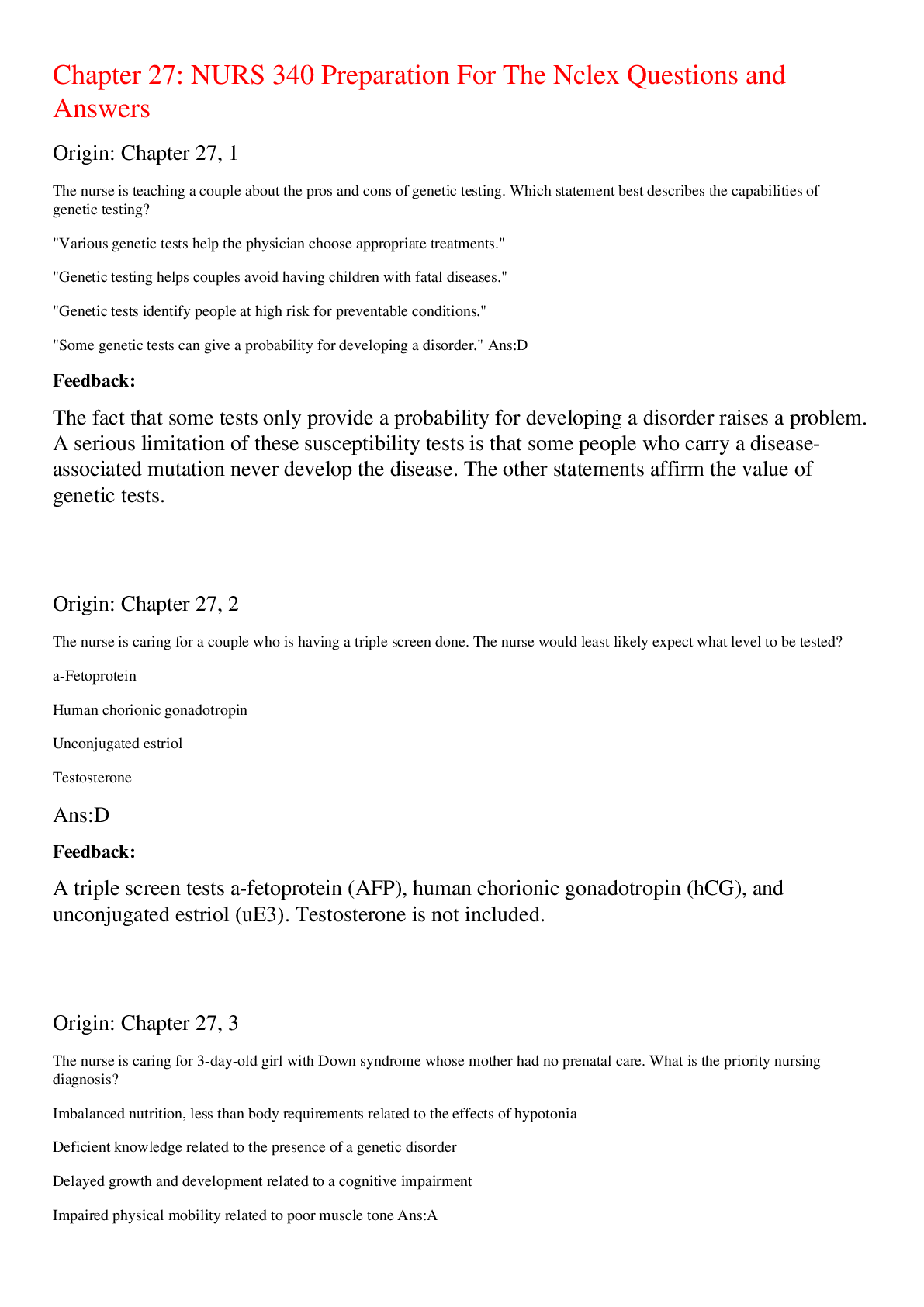
Buy this document to get the full access instantly
Instant Download Access after purchase
Buy NowInstant download
We Accept:

Reviews( 0 )
$15.00
Can't find what you want? Try our AI powered Search
Document information
Connected school, study & course
About the document
Uploaded On
Mar 06, 2023
Number of pages
14
Written in
All
Additional information
This document has been written for:
Uploaded
Mar 06, 2023
Downloads
0
Views
81

